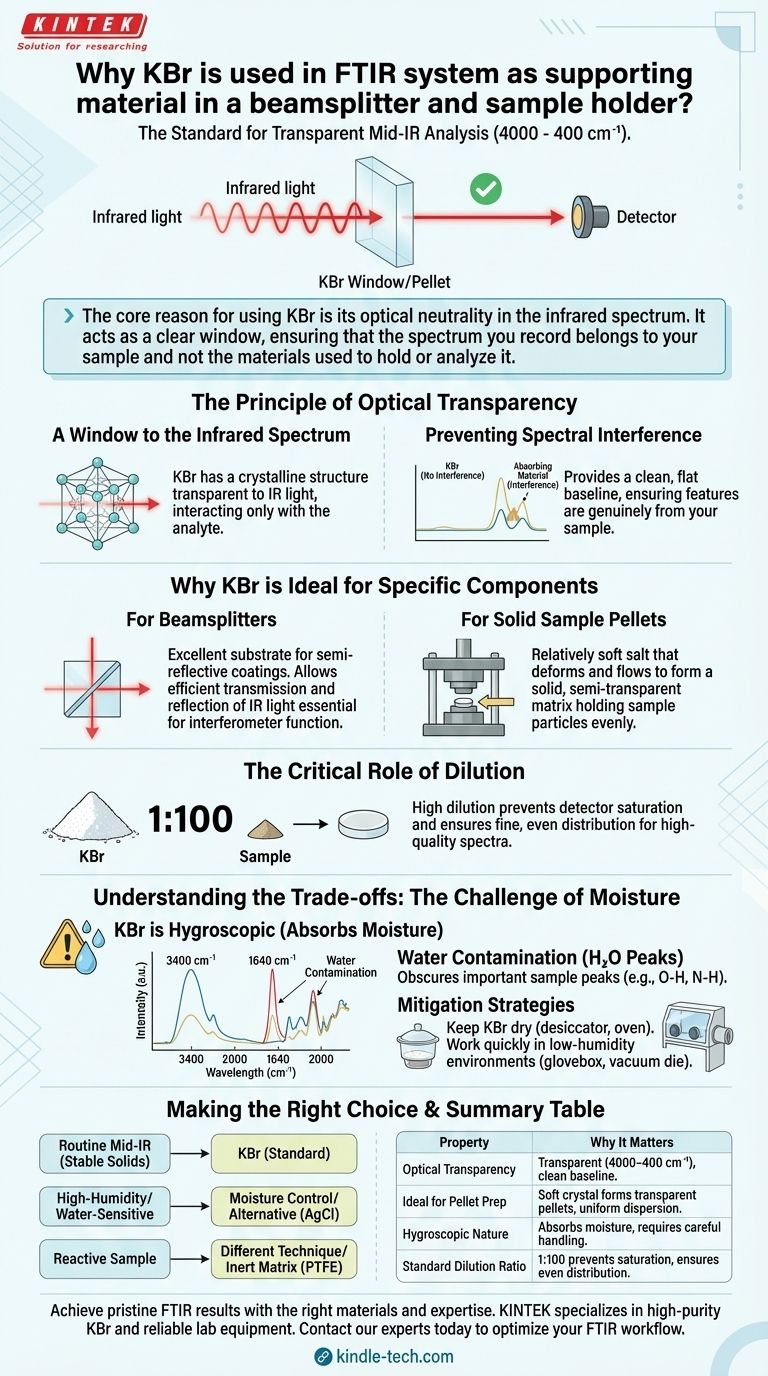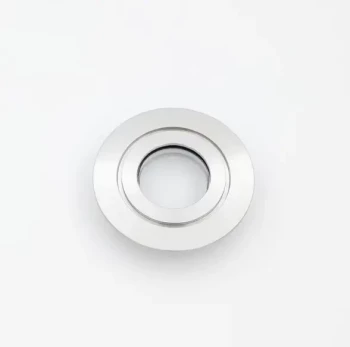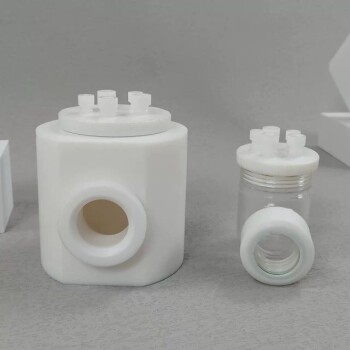溴化钾(KBr)是FTIR分束器和样品架的标准材料,主要是因为它在宽广的中红外范围(4000至400 cm⁻¹)内对红外辐射是透明的。这一关键特性确保了KBr本身不吸收红外光,从而使仪器能够测量样品的吸收光谱,而不会受到支撑材料的干扰。
使用KBr的核心原因是它在红外光谱中的光学中性。它就像一个透明的窗口,确保您记录的光谱属于您的样品,而不是用于盛放或分析它的材料。
光学透明性原理
红外光谱的窗口
放置在FTIR光谱仪光束路径中的任何材料的基本要求是它不应干扰测量。KBr具有晶体结构,在最常分析的红外光谱区域不吸收光。
这种透明性允许红外光穿过KBr组件——无论是分束器基底还是样品压片——并仅与感兴趣的分析物相互作用。
防止光谱干扰
如果支撑材料吸收红外光,其自身的光谱峰将出现在最终测量中。这些干扰峰可能会与实际样品的峰重叠或遮盖,使数据解释变得困难或不可能。
KBr在该区域没有吸收带,提供了干净、平坦的基线,确保您看到的光谱特征确实来自您的样品。

为什么KBr是特定组件的理想选择
用于分束器
分束器是必须精确分割红外光束的关键光学组件。KBr是分束器半反射涂层的优良基底材料。
其宽广的透明范围和合适的折射率允许红外光的高效透射和反射,这对于干涉仪的正常运行至关重要。
用于固体样品压片
KBr是一种相对柔软的晶体盐。当与固体样品精细研磨并施加高压(使用压片机)时,它会变形并流动,形成一个坚固、半透明的圆盘或“压片”。
这个过程创建了一个固体基质,使样品颗粒均匀分散在红外光束的路径中。这是一种简单有效的方法,用于分析不溶于红外透明溶剂的固体样品。
稀释的关键作用
通常,样品与KBr的混合比例约为1:100(样品与KBr)。这种高稀释度至关重要,原因有二。
首先,它防止样品的红外吸收变得过强并使检测器饱和。其次,它确保样品在压片中分布均匀细致,从而最大限度地减少光散射并产生更高质量的光谱。
了解权衡:湿气的挑战
KBr具有吸湿性
尽管KBr具有优异的光学性能,但它有一个显著的缺点:它具有吸湿性。这意味着它很容易从大气中吸收水分。
这一特性是其主要的局限性,需要仔细处理以确保准确测量。
水污染的影响
水(H₂O)是红外辐射的强吸收剂,在3400 cm⁻¹附近显示出非常宽的吸收带,在1640 cm⁻¹附近显示出另一个尖锐的吸收带。
如果用于压片的KBr从空气中吸收了水分,这些大的水峰将出现在光谱中。这可能会完全遮盖这些区域中重要的样品峰,例如O-H和N-H伸缩振动。
缓解策略
为了获得干净的光谱,KBr必须保持绝对干燥。它应储存在干燥器中或在使用前在烘箱中烘干。
在制备压片时,尤其是在潮湿环境中,必须迅速操作。为了获得最佳结果,研磨样品和压制压片应在低湿度环境中进行,例如在手套箱内或使用专用真空模具。
为您的分析做出正确选择
了解KBr的特性可以帮助您有效使用它并解决潜在问题。
- 如果您的主要关注点是稳定固体样品的常规中红外分析: KBr是经济高效的行业标准,如果处理得当,可提供出色的结果。
- 如果您在潮湿环境或分析对水敏感的样品: 您必须实施严格的湿度控制(例如使用干燥器和手套箱)或考虑替代压片材料,如氯化银(AgCl)。
- 如果已知您的样品与碱金属卤化物反应: 您必须使用不同的分析技术或惰性基质,如PTFE,同时注意其自身有限的透明区域。
最终,掌握您的材料是实现干净、可靠和准确光谱分析的第一步。
总结表:
| 特性 | 对FTIR的重要性 |
|---|---|
| 光学透明性 | 在4000-400 cm⁻¹范围内透明,提供干净的基线,无光谱干扰。 |
| 压片制备的理想选择 | 柔软的晶体在加压时形成透明压片,允许样品均匀分散。 |
| 吸湿性 | 吸收水分,需要小心处理(例如,干燥,使用手套箱)以避免光谱中出现水峰。 |
| 标准稀释比 | 典型的1:100样品与KBr比例可防止检测器饱和并确保颗粒均匀分布。 |
利用正确的材料和专业知识,获得原始的FTIR结果。 KINTEK专注于高纯度KBr和可靠的实验室设备,用于准确的光谱分析。我们的团队可以帮助您选择完美的耗材并实施最佳实践以减轻潮湿问题。 立即联系我们的专家,优化您的FTIR工作流程并确保您数据的完整性。
图解指南














